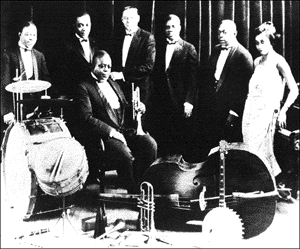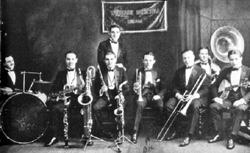 Dixieland Jazz started in New Orleans, the birth place of Jazz around the 1900�s. It started in New Orleans because its cultural heritage was exceptionally diverse even for immigrant laden America. It had several culture groups, French, Spanish, Creoles and African American Blacks. It also encouraged dances and music, letting the "Black" inhabitants play African music and drums that Plantation Owners banned. Although the war had ended military music was still in fashion for parades, dances that all social classes enjoyed, and on the way to and from funerals. Musicians in New Orleans performed a wide range of material from "quadrilles" and "mazurka�s" to "slow drags" "barrel house" "plantation music" and "bumpy" tunes such as the St. Louis Blues.
Dixieland Jazz started in New Orleans, the birth place of Jazz around the 1900�s. It started in New Orleans because its cultural heritage was exceptionally diverse even for immigrant laden America. It had several culture groups, French, Spanish, Creoles and African American Blacks. It also encouraged dances and music, letting the "Black" inhabitants play African music and drums that Plantation Owners banned. Although the war had ended military music was still in fashion for parades, dances that all social classes enjoyed, and on the way to and from funerals. Musicians in New Orleans performed a wide range of material from "quadrilles" and "mazurka�s" to "slow drags" "barrel house" "plantation music" and "bumpy" tunes such as the St. Louis Blues.
Creoles were a mixed race group that had their own cultural identity. As their surnames made clear their backgrounds were often French, perhaps the free descendants of wealthy landowners and their Black mistresses. They were influenced by France and Latin Europe and were craftsmen and small tradesmen that were educated well and aspired to European standards of excellence. The Creoles were well trained and had musical fluency, but generally didn�t improvise.
The "Blacks" had one great asset, the rhythmic flair that came from Africa. They didn�t and generally couldn�t read music but instead played "head" music, i.e., by ear and memory. When they got to New Orleans the "Black" players took up the instruments of the Creole bands, i.e., cornet or trumpet, clarinet, trombone, banjo, drums, string bass or tuba, etc. At moments of emotional climax they continued to roughen their instrumental sounds like a gospel or blues singer would, and unlike the Creoles, they improvised.
 A racist law forced these two groups previously weary of each other to musically coexist. Storyville provided the employment for these "Black" and Creole musicians. Storyville, named after Joseph Story a local politician, sponsored laws confining all prostitution, which was so wide spread, to one area of New Orleans. This area proved to be a main attraction for tens of thousand's tourists and sailors on leave. This all changed in 1917 when Storyville closed and accelerated the migration already in progress further north, i.e. ,Chicago and New York.
A racist law forced these two groups previously weary of each other to musically coexist. Storyville provided the employment for these "Black" and Creole musicians. Storyville, named after Joseph Story a local politician, sponsored laws confining all prostitution, which was so wide spread, to one area of New Orleans. This area proved to be a main attraction for tens of thousand's tourists and sailors on leave. This all changed in 1917 when Storyville closed and accelerated the migration already in progress further north, i.e. ,Chicago and New York.
Exactly who contributed what and when, we are never likely to know, as no recordings were made of Dixieland and Jazz till 1917, when Nick La Rocca�s Original Dixieland Jazz (Jass) band made the first Jazz record in Chicago. Although this music was "Black" and not excepted by the majority of "Whites" the ODJB being white made it fashionable and made way for the "Blacks" and Creole�s to then record their versions. When the ODJB went to Europe the Europeans thought they were very good until a year later Sidney Bechet (a Creole) came along and played and showed that Creoles and "Blacks" generally played Jazz better. The movements of these bands and players took Jazz to Europe and surrounding countries were it became popular.
A Dixieland Jazz Band would usually consist of a tuba or string bass playing the bass line. A melody line that a trumpet or cornet would usually play, a counter melody (usually clarinet), and an inner part usually trombone. Sometime you had a rhythm section like a banjo or drums. When Dixieland moved further north, some of the instruments started to change. Clarinet would be replaced with an alto saxophone, the trombone would be replaced with a tenor saxophone, and the banjo would be replaced with a piano or guitar. Dixieland is basically Ragtime Piano played on instruments. Ragtime piano had a strong melody with lots of syncopation (cornet/trumpet), counter melodies (clarinet), inner parts (trombone) and a solid bass line (bass/tuba). The idea of a Dixieland band was that it was a portable group for the parades, parties and things they played at, where as with ragtime you couldn�t walk around with a piano!
The typical form of the songs involved collective improvisation for the first chorus. Individual solo�s with some riffing by other horns, and a closing ensemble or two with a four bar tag by the drummer being answered by the whole group. Although nearly any song can be turned into Dixieland Jazz there is a constant repertoire of forty or so songs that have been proven consistently reliable.
Dixieland had a revival in 1930�s and 40�s when some musicians had had enough of swing and no instrumental solo�s because of the singers. They wished to return to the more simple traditional Jazz of the early 1900�s-20�s.
 Some notable Dixieland Jazz performers and Bands include, New Orleans Rhythm Kings (white group), The Wolverines, Trumbauer�s Orchestra, King Oliver�s Creole Jazz Band, Pianist Jelly Roll Morton, "white" Trumpet player Bix Beiderbecke, Clarinetist Johnny Dodds, Trumpet player King Oliver, Trombonist Kid Ory, and Soprano Saxophone and Clarinet player Sidney Bechet.
Some notable Dixieland Jazz performers and Bands include, New Orleans Rhythm Kings (white group), The Wolverines, Trumbauer�s Orchestra, King Oliver�s Creole Jazz Band, Pianist Jelly Roll Morton, "white" Trumpet player Bix Beiderbecke, Clarinetist Johnny Dodds, Trumpet player King Oliver, Trombonist Kid Ory, and Soprano Saxophone and Clarinet player Sidney Bechet.
This site was updated on the 28th of April 1998
� 1997 [email protected]
This page hosted by  Get your own Free Home Page
Get your own Free Home Page
 Dixieland Jazz started in New Orleans, the birth place of Jazz around the 1900�s. It started in New Orleans because its cultural heritage was exceptionally diverse even for immigrant laden America. It had several culture groups, French, Spanish, Creoles and African American Blacks. It also encouraged dances and music, letting the "Black" inhabitants play African music and drums that Plantation Owners banned. Although the war had ended military music was still in fashion for parades, dances that all social classes enjoyed, and on the way to and from funerals. Musicians in New Orleans performed a wide range of material from "quadrilles" and "mazurka�s" to "slow drags" "barrel house" "plantation music" and "bumpy" tunes such as the St. Louis Blues.
Dixieland Jazz started in New Orleans, the birth place of Jazz around the 1900�s. It started in New Orleans because its cultural heritage was exceptionally diverse even for immigrant laden America. It had several culture groups, French, Spanish, Creoles and African American Blacks. It also encouraged dances and music, letting the "Black" inhabitants play African music and drums that Plantation Owners banned. Although the war had ended military music was still in fashion for parades, dances that all social classes enjoyed, and on the way to and from funerals. Musicians in New Orleans performed a wide range of material from "quadrilles" and "mazurka�s" to "slow drags" "barrel house" "plantation music" and "bumpy" tunes such as the St. Louis Blues. A racist law forced these two groups previously weary of each other to musically coexist. Storyville provided the employment for these "Black" and Creole musicians. Storyville, named after Joseph Story a local politician, sponsored laws confining all prostitution, which was so wide spread, to one area of New Orleans. This area proved to be a main attraction for tens of thousand's tourists and sailors on leave. This all changed in 1917 when Storyville closed and accelerated the migration already in progress further north, i.e. ,Chicago and New York.
A racist law forced these two groups previously weary of each other to musically coexist. Storyville provided the employment for these "Black" and Creole musicians. Storyville, named after Joseph Story a local politician, sponsored laws confining all prostitution, which was so wide spread, to one area of New Orleans. This area proved to be a main attraction for tens of thousand's tourists and sailors on leave. This all changed in 1917 when Storyville closed and accelerated the migration already in progress further north, i.e. ,Chicago and New York. Some notable Dixieland Jazz performers and Bands include, New Orleans Rhythm Kings (white group), The Wolverines, Trumbauer�s Orchestra, King Oliver�s Creole Jazz Band, Pianist Jelly Roll Morton, "white" Trumpet player Bix Beiderbecke, Clarinetist Johnny Dodds, Trumpet player King Oliver, Trombonist Kid Ory, and Soprano Saxophone and Clarinet player Sidney Bechet.
Some notable Dixieland Jazz performers and Bands include, New Orleans Rhythm Kings (white group), The Wolverines, Trumbauer�s Orchestra, King Oliver�s Creole Jazz Band, Pianist Jelly Roll Morton, "white" Trumpet player Bix Beiderbecke, Clarinetist Johnny Dodds, Trumpet player King Oliver, Trombonist Kid Ory, and Soprano Saxophone and Clarinet player Sidney Bechet.
